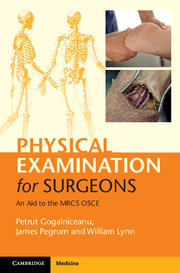Book contents
- Frontmatter
- Dedication
- Contents
- List of contributors
- Introduction
- Acknowledgments
- List of abbreviations
- Section 1 Principles of surgery
- Section 2 General surgery
- Section 3 Breast surgery
- Section 4 Pelvis and perineum
- Section 5 Orthopaedic surgery
- Section 6 Vascular surgery
- Section 7 Heart and thorax
- Section 8 Head and neck surgery
- Section 9 Neurosurgery
- Section 10 Plastic surgery
- 39 Examination of skin lesions and lumps
- 40 Examination of scars
- 41 Examination of flaps and grafts
- 42 Examination of burns
- 43 Examination of the hands
- Section 11 Surgical radiology
- Section 12 Airway, trauma and critical care
- Index
40 - Examination of scars
from Section 10 - Plastic surgery
Published online by Cambridge University Press: 05 July 2015
- Frontmatter
- Dedication
- Contents
- List of contributors
- Introduction
- Acknowledgments
- List of abbreviations
- Section 1 Principles of surgery
- Section 2 General surgery
- Section 3 Breast surgery
- Section 4 Pelvis and perineum
- Section 5 Orthopaedic surgery
- Section 6 Vascular surgery
- Section 7 Heart and thorax
- Section 8 Head and neck surgery
- Section 9 Neurosurgery
- Section 10 Plastic surgery
- 39 Examination of skin lesions and lumps
- 40 Examination of scars
- 41 Examination of flaps and grafts
- 42 Examination of burns
- 43 Examination of the hands
- Section 11 Surgical radiology
- Section 12 Airway, trauma and critical care
- Index
Summary
Checklist
WIPER
Physiological parameters
Look
• Anatomy: Site, Orientation, Length, Colour, Contracture
• Healing status: fresh, healing, healed, mature
• Healing method: primary or secondary intention
• Pathological scarring: hypertrophic or keloid changes, scar widening or stretching
• Infection: sinuses, fistulas, granulation or discharge
• Signs of surgical correction (e.g. z-plasty)
Feel
• Tenderness
• Thickness, pliability
• Adherence
• Evidence of malignant occurrence or recurrence
Move
• Mobility of scar
• Mobility and laxity of surrounding skin
• Associated functional impairment (test related muscles, joints and nerves)
To complete the examination…
• Assess regional lymph nodes.
• Obtain formal function assessment by occupational therapist/physiotherapist as required.
Examination notes
How do wounds heal?
Skin scarring is the normal and inevitable outcome of cutaneous wound healing. Wound healing follows a sequence of overlapping phases: haemostasis, inflammation, proliferation and remodelling.
What factor must be considered on inspection?
• Cause: Consider underlying medical comorbidities that led to the scar, but never assume the surgical procedure if this information has not been given.
• Colour: An assessment of the colour of the scar may indicate its age. Wound healing has defined sequential yet overlapping stages within which the scar will change in colour. As a scar passes from the proliferative phase through to remodelling and finally into a mature scar so its colour will decrease in red pigmentation. A variegated pink scar is younger than a homogeneous white scar.
• Location: The position of the scar indicates potential functional complications. If the scar is over a joint there is a risk of contractures causing decreased range of movement. Assess for underlying neurovascular function and deficits following surgery or injury: for example, periorbital scars may be associated with ectropion directly from cicatricial healing, or weakness due to damage to the temporal branch of the facial nerve (CN VII), or a sensory loss due to trigeminal nerve (CN V1) injuries.
- Type
- Chapter
- Information
- Physical Examination for SurgeonsAn Aid to the MRCS OSCE, pp. 359 - 361Publisher: Cambridge University PressPrint publication year: 2015



